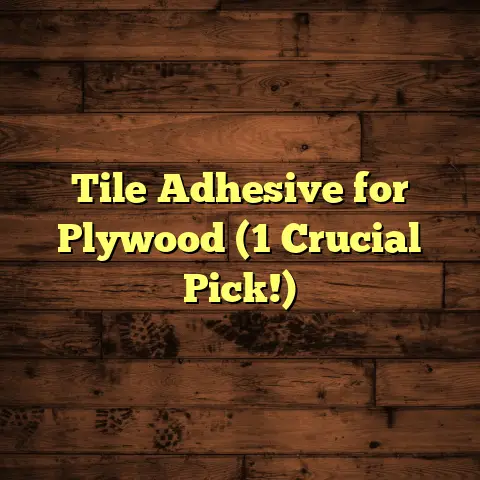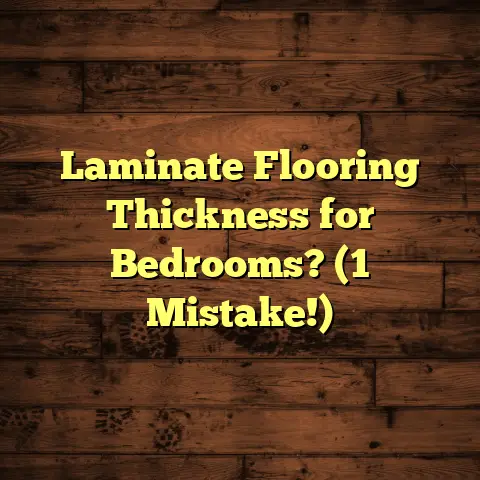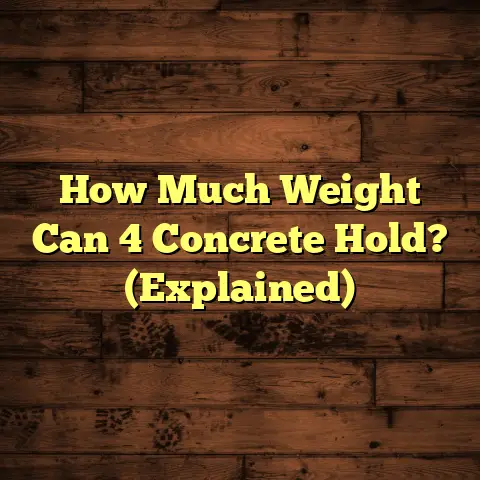Concrete Moisture Signs? (3 Warning Signs!)
It’s super popular for homes and businesses, right?
I’ve installed tons of it over the years.
It’s durable, looks great, and seems easy to install.
But here’s a secret: concrete isn’t invincible.
Moisture can sneak in and cause big problems if we’re not careful.
Think of it like this: a small leak can turn into a flooding disaster if you don’t catch it early.
That’s why I want to talk about concrete moisture signs.
Spotting these early can save you a ton of headaches and money down the road.
Let’s dive in!
1. Understanding Concrete and Its Moisture Dynamics
So, what exactly is concrete, and why does it care about moisture?
Let’s break it down.
1.1 The Nature of Concrete
Concrete is basically a mix of cement, water, and aggregates like sand and gravel.
The cement acts like a glue, binding everything together as it hardens.
But here’s the thing: even though it looks solid, concrete is actually porous.
Think of it like a really dense sponge.
It has tiny little holes and channels that water can seep into.
This porosity is a big deal because it means concrete can absorb and release moisture from its surroundings.
According to the Portland Cement Association, concrete can absorb up to 12% of its weight in water. (Source: Portland Cement Association)
That’s a lot of potential moisture lurking in your floor!
1.2 Sources of Moisture
Where does all this moisture come from anyway?
Well, there are a few common culprits.
-
Ground Moisture: This is a big one, especially if your concrete slab is in direct contact with the ground. Water can wick up through the soil and into the concrete through capillary action. This is more common in basements or slabs that don’t have a proper vapor barrier underneath.
-
Plumbing Leaks: A leaky pipe, even a small one, can introduce a ton of moisture into your concrete over time. Think about a slow drip under your sink. Where does that water go? Often right into the floor.
-
Humidity: High humidity can also contribute to moisture problems, especially in poorly ventilated areas. Concrete can absorb moisture from the air, especially if it’s cooler than the surrounding environment.
-
Spills and Flooding: Obvious, right? But even small spills that aren’t cleaned up properly can seep into the concrete and cause issues.
2. The Importance of Recognizing Moisture Signs
Okay, so we know concrete can absorb moisture.
But why is that such a big deal?
2.1 Why Moisture Matters
Excess moisture in concrete can lead to a whole host of problems, trust me, I’ve seen them all.
-
Structural Damage: When water freezes inside concrete, it expands, putting pressure on the material. Over time, this can lead to cracking and weakening of the concrete structure.
-
Mold Growth: Mold loves damp, dark places. Concrete with excess moisture is the perfect breeding ground. Mold can cause respiratory problems, allergies, and other health issues.
-
Compromised Indoor Air Quality: Mold isn’t the only thing that can affect air quality. Damp concrete can also release volatile organic compounds (VOCs) from adhesives and sealants, further polluting the air you breathe.
-
Adhesive Failure: If you’re planning on installing any type of flooring over concrete (tile, hardwood, carpet), moisture can interfere with the adhesive, causing it to fail. This can lead to loose tiles, buckling hardwood, and other flooring nightmares.
-
Financial Implications: Ignoring moisture problems can be incredibly costly in the long run. What starts as a small issue can quickly escalate into major structural repairs, mold remediation, and flooring replacement.
According to the EPA, moisture problems can reduce the value of a home by as much as 15%. (Source: Environmental Protection Agency)
That’s a serious hit to your property value!
3. The Three Warning Signs of Moisture in Concrete
Alright, now let’s get to the heart of the matter: how do you actually spot moisture problems in concrete?
Here are three warning signs I always look for:
Warning Sign 1: Visible Water Damage
This is the most obvious sign, but it’s still important to pay attention.
What does visible water damage look like?
-
Discoloration: Damp concrete will often appear darker than dry concrete. You might notice dark spots or streaks on the surface.
-
Efflorescence: This is a white, powdery deposit that can appear on the surface of concrete. It’s caused by salts that are dissolved in water and then carried to the surface as the water evaporates.
-
Damp Spots: This one’s pretty straightforward. If you see areas of the concrete that are consistently damp, even when the rest of the floor is dry, that’s a red flag.
Think of it like a persistent puddle that never quite dries.
-
Peeling Paint or Coatings: If you’ve painted or sealed your concrete floor, moisture can cause the paint or coating to peel, bubble, or blister.
Visual Examples:
-
Discoloration: Imagine a concrete floor in a basement. You notice a large, dark patch near one of the walls. This discoloration is a clear sign of moisture intrusion.
-
Efflorescence: Picture a concrete patio. You see a white, powdery substance accumulating along the edges of the slabs. That’s efflorescence.
-
Damp Spots: Envision a concrete garage floor. Even after a dry spell, there’s always a damp spot near the corner of the garage.
Warning Sign 2: Musty Odors
Smell something funky?
A musty or mildew smell is a strong indicator of underlying moisture issues, even if you can’t see any visible signs of water damage.
-
The Mold Connection: Musty odors are often caused by mold growth. As mold grows, it releases volatile organic compounds (VOCs), which are responsible for that distinctive smell.
-
Health Risks: Mold exposure can cause a variety of health problems, including respiratory irritation, allergies, asthma attacks, and even more serious infections in people with weakened immune systems.
The CDC has extensive information on the health effects of mold. (Source: Centers for Disease Control and Prevention)
-
Hidden Problems: Sometimes, the source of the odor is hidden behind walls, under flooring, or in other inaccessible areas. That’s why it’s important to take any musty smell seriously, even if you can’t immediately identify the source.
Think of it like this: if you smell something rotten in your fridge, you know something’s not right, even if you can’t see the spoiled food right away.
A musty odor in your home should be treated the same way.
Warning Sign 3: Cracking and Buckling
Cracking and buckling in concrete floors can be caused by a variety of factors, but moisture is often a significant contributor.
-
Types of Cracks:
-
Hairline Cracks: These are small, narrow cracks that are often superficial and don’t necessarily indicate a serious problem. However, they can still allow moisture to penetrate the concrete.
-
Structural Cracks: These are wider, deeper cracks that can compromise the structural integrity of the concrete. They’re often caused by excessive stress, settlement, or moisture expansion.
-
Heaving Cracks: These cracks occur when the concrete is pushed upward, often due to freezing and thawing cycles or expansive soils.
-
-
Buckling: Buckling is a more severe form of damage where the concrete actually lifts up off the subfloor. This is often caused by extreme moisture expansion or hydrostatic pressure (water pressure from below).
-
Moisture’s Role: When concrete absorbs moisture, it expands slightly. If the concrete is restrained (e.g., by walls or other structures), this expansion can create stress that leads to cracking and buckling.
Also, as I mentioned earlier, freezing water expands, exerting even more pressure on the concrete.
Think of it like this: imagine trying to squeeze too many books onto a bookshelf. Eventually, something’s going to crack or buckle under the pressure.
Cracking and buckling in concrete are often a sign that the concrete is under stress from moisture.
4. Consequences of Ignoring Moisture Signs
So, what happens if you ignore these warning signs?
Let me tell you, it’s not pretty.
-
Structural Integrity: Over time, moisture can weaken the concrete, making it more susceptible to cracking, crumbling, and even collapse. This can compromise the safety of your home or building.
-
Safety Hazards: Cracks and buckling can create trip hazards, increasing the risk of falls and injuries.
-
Mold and Mildew: As we’ve already discussed, moisture promotes mold growth, which can lead to health problems and unpleasant odors.
-
Flooring Damage: Moisture can damage any type of flooring installed over the concrete, including tile, hardwood, carpet, and laminate. This can result in costly repairs or replacements.
-
Increased Repair Costs: The longer you wait to address moisture problems, the more extensive and expensive the repairs will be. What starts as a simple crack repair can eventually turn into a major structural renovation.
-
Reduced Property Value: Moisture problems can significantly reduce the value of your home or building. Potential buyers will be turned off by signs of water damage, mold, and structural issues.
I’ve seen situations where homeowners ignored small moisture problems for years, only to end up facing tens of thousands of dollars in repairs.
Don’t let that happen to you!
5. Conclusion
Concrete flooring is a fantastic choice for many reasons.
It’s durable, versatile, and can look amazing.
But it’s not immune to moisture problems.
By being aware of the three warning signs I’ve discussed – visible water damage, musty odors, and cracking/buckling – you can catch moisture issues early and prevent them from escalating into major headaches.
Remember, awareness and prompt action are key to maintaining the longevity, safety, and value of your concrete installations.
Don’t hesitate to call in a professional if you suspect you have a moisture problem.
A qualified flooring contractor or moisture specialist can assess the situation, identify the source of the moisture, and recommend the best course of action.
Your concrete floor will thank you for it!





